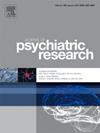失声症患者的情绪失调:来自全国代表性样本的研究结果。
IF 3.7
2区 医学
Q1 PSYCHIATRY
引用次数: 0
摘要
失声症的核心特征是对特定声音(如啧啧声、钢笔点击声)产生情绪困扰。尽管理论上认为情绪失调与失声症之间存在联系,但这方面的研究却很少。研究情绪失调并确定与失声症状加重相关的特定情绪调节缺陷,将促进我们对导致失声症状的潜在跨诊断因素的了解,从而为制定更有针对性的干预措施提供信息。本研究旨在1)描述失声症患者情绪失调的特征;2)比较临床和亚临床失声症患者的情绪失调;3)研究情绪失调在失声症症状的三个领域中的独特作用。这项研究包括一个具有全国代表性的大型美国成年人样本(样本数 = 4005;51.5% 为女性;62.5% 为非西班牙裔白人)。参与者填写了自我报告问卷,以评估失音症状(即失音声音、对失音声音的情绪和行为反应以及与失音相关的损伤)、压力和情绪失调。结果显示,与亚临床水平的失音患者相比,失音患者的情绪调节能力明显较差。此外,情绪失调与对误发音的敏感性、对误发音的反应以及与误发音相关的损伤有显著关联,即使在考虑了协变量之后也是如此。研究结果表明,情绪失调是失声症的一个重要因素,并建议在今后的研究和评估用于减轻失声症症状的治疗策略时,应考虑情绪失调的某些方面。本文章由计算机程序翻译,如有差异,请以英文原文为准。
Emotion dysregulation in misophonia: Findings from a nationally representative sample
A core feature of misophonia is the emotional distress that occurs in response to specific sounds (e.g., slurping, pen clicking). Despite the theorized connection between emotion dysregulation and misophonia, there is very little research on this topic. Examining emotion dysregulation and identifying the specific emotion regulation deficits that are associated with worse misophonia symptoms would advance our understanding of potential transdiagnostic factors central to misophonia symptoms; thereby informing the development of more targeted interventions. The current study sought to: 1) characterize emotion dysregulation among individuals with misophonia, 2) compare emotion dysregulation between individuals with clinical and subclinical misophonia, and 3) examine the unique role of emotion dysregulation across three domains of misophonia symptoms. This study included a large, nationally representative sample of U.S. adults (N = 4005; 51.5% female; 62.5% White, non-Hispanic). Participants completed self-report questionnaires to assess misophonia symptoms (i.e., misophonia sounds, emotional and behavioral reactions to misophonia sounds, and misophonia-related impairment), stress, and emotion dysregulation. The results revealed participants with misophonia reported significantly worse emotion regulation abilities compared to individuals with subclinical levels of misophonia. In addition, emotion dysregulation was significantly associated with sensitivity to misophonia sounds, reactions to misophonia sounds, and misophonia-related impairment, even after accounting for covariates. Results support emotion dysregulation as an important element in misophonia and suggest certain dimensions of emotion dysregulation should be considered in future research and in the evaluation of treatment strategies used to reduce misophonia symptoms.
求助全文
通过发布文献求助,成功后即可免费获取论文全文。
去求助
来源期刊

Journal of psychiatric research
医学-精神病学
CiteScore
7.30
自引率
2.10%
发文量
622
审稿时长
130 days
期刊介绍:
Founded in 1961 to report on the latest work in psychiatry and cognate disciplines, the Journal of Psychiatric Research is dedicated to innovative and timely studies of four important areas of research:
(1) clinical studies of all disciplines relating to psychiatric illness, as well as normal human behaviour, including biochemical, physiological, genetic, environmental, social, psychological and epidemiological factors;
(2) basic studies pertaining to psychiatry in such fields as neuropsychopharmacology, neuroendocrinology, electrophysiology, genetics, experimental psychology and epidemiology;
(3) the growing application of clinical laboratory techniques in psychiatry, including imagery and spectroscopy of the brain, molecular biology and computer sciences;
 求助内容:
求助内容: 应助结果提醒方式:
应助结果提醒方式:


